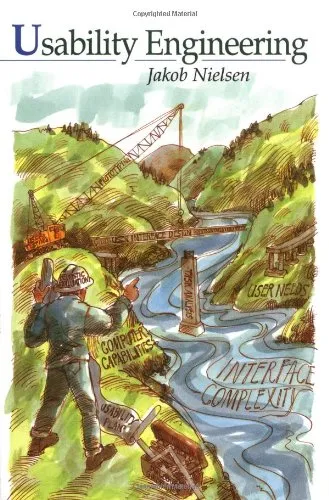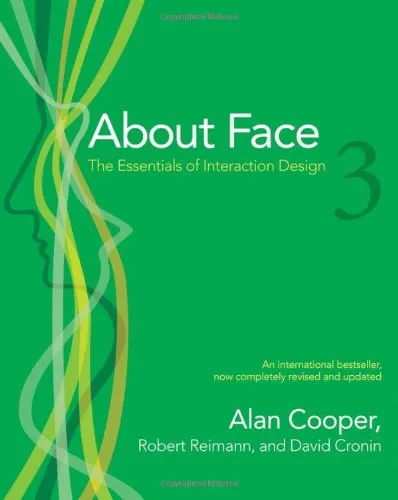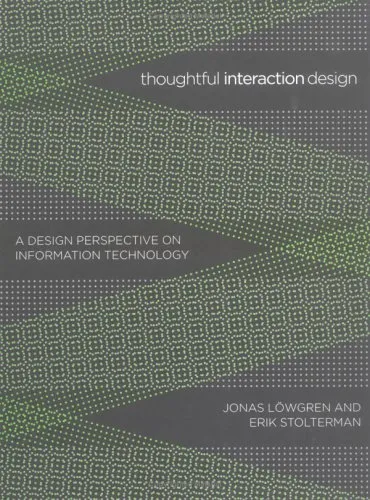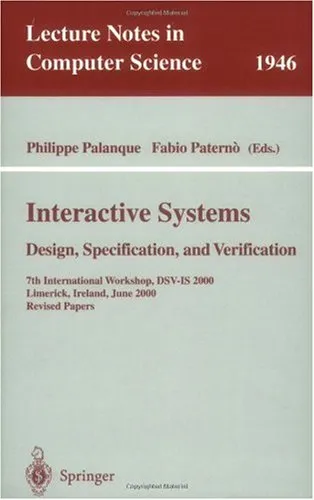Interactive Systems. Design, Specification, and Verification: 15th International Workshop, DSV-IS 2008 Kingston, Canada, July 16-18, 2008 Revised Papers
4.0
بر اساس نظر کاربران

شما میتونید سوالاتتون در باره کتاب رو از هوش مصنوعیش بعد از ورود بپرسید
هر دانلود یا پرسش از هوش مصنوعی 2 امتیاز لازم دارد، برای بدست آوردن امتیاز رایگان، به صفحه ی راهنمای امتیازات سر بزنید و یک سری کار ارزشمند انجام بدینکتاب های مرتبط:
معرفی کتاب: Interactive Systems. Design, Specification, and Verification
کتاب «Interactive Systems: Design, Specification, and Verification» که به عنوان بخشهای بازنگریشده پانزدهمین کارگاه بینالمللی DSV-IS در سال ۲۰۰۸ در کینگستون، کانادا منتشر شده است، یکی از آثار علمی برجسته در حوزه تعاملیسازی سیستمها میباشد. این کتاب به بررسی اصول طراحی، مشخصات و اعتبارسنجی سیستمهای تعاملی پرداخته و با ترکیب تحقیقات و تجربههای واقعی، به ارائه دیدگاههای جدید در زمینه Human-Computer Interaction میپردازد.
خلاصهای جامع از کتاب
این اثر علمی شامل مجموعهای از مقالات بازنگریشده است که توسط پژوهشگران برجسته در حوزه طراحی سیستمهای تعاملی ارائه شده است. موضوعات مورد بحث شامل اصول طراحی تعامل محور، مشخصهگذاری سیستمهای پیچیده، و روشهای ارزیابی دقیق برای تضمین اعتبار و کارایی سیستم میشوند. این کتاب بر مذاکرات انجامشده در کارگاههای علمی تمرکز دارد و راهحلهایی را برای چالشهای موجود در سیستمهای تعاملی بهویژه در محیطهای خاص مانند سامانههای بحرانی و خلاقانه ارائه میکند.
به طور خاص، این کتاب موضوعاتی نظیر Formal Methods در طراحی سیستمها، مدلسازی کاربر و تحلیل نیازهای کاربران را بررسی میکند. تحلیلها و یافتههای ارائه شده در این کتاب، پایهای ارزشمند برای بهبود تجربه کاربری، طراحی کارآمد و ایجاد سیستمهای قابل اعتماد است.
درسهای کلیدی از کتاب
- اهمیت بهکارگیری Formal Methods در بهبود کیفیت سیستمهای تعاملی.
- نقش مدلسازی شناختی کاربر در تعامل موفق او با فناوریها.
- روشهای نوآورانه بررسی و افزایش قابلیت اعتماد در سیستمهای حیاتی.
- ارتقای درک انسان از طراحی تعاملی از طریق تکنیکهای تحلیل مبتنی بر داده.
- ادغام طراحی سیستم با الزامات Human Factors برای ایجاد تجربه کاربری بهتر.
نقلقولهای معروف از کتاب
"Design is not just about aesthetics; it is about understanding and enhancing the user's ability to effectively interact."
"Formal methods provide the backbone for reliable and robust interactive systems."
چرا این کتاب اهمیت دارد؟
کتاب «Interactive Systems: Design, Specification, and Verification» به دلیل جامعیت، عمق تحلیلها و تمرکز بر چالشهای واقعی دنیای فناوری، اهمیت ویژهای دارد. این اثر نه تنها ابزارهایی برای طراحان سیستم فراهم میآورد، بلکه همچنین به پژوهشگران و دانشجویان امکان میدهد تا مفاهیم کلیدی طراحی تعاملی را عمیقتر درک کنند. روشهای ارائه شده در این کتاب میتوانند به عنوان راهنمایی برای بهبود تعامل انسان و کامپیوتر در انواع زمینهها از طراحی سیستمهای بحرانی تا اپلیکیشنهای روزمره مورد استفاده قرار گیرند.
افزون بر این، این کتاب پلی میان نظریه و عمل است؛ از یک سو به تئوریهای علمی پرداخته و از سوی دیگر مثالهای عملی و کاربردی برای سادهسازی مفاهیم پیچیده ارائه میکند. با استفاده از این کتاب، خوانندگان قادر خواهند بود تا دیدگاهی جامع نسبت به طراحی سیستمهای تعاملی پیدا کرده و در اجرای پروژههای خود از رهنمودهای آن بهرهمند شوند.
Introduction to "Interactive Systems. Design, Specification, and Verification: 15th International Workshop, DSV-IS 2008"
This book is a comprehensive collection of revised papers presented at the 15th International Workshop on Design, Specification, and Verification of Interactive Systems (DSV-IS 2008). Held in Kingston, Canada, from July 16-18, 2008, this workshop brought together researchers, practitioners, and thought leaders in the field of human-computer interaction (HCI) to discuss the challenges and innovations in interactive system design and usability. The book serves as a repository of expert knowledge and cutting-edge research, catering to both academics and practitioners seeking to deepen their understanding of interactive systems.
Detailed Summary of the Book
The book delves into the multi-faceted nature of interactive systems, emphasizing theories, methodologies, tools, and real-world applications. Each chapter represents a scholarly contribution addressing key design challenges faced when developing interactive systems, particularly those involving complex user interfaces. Topics range from formal specification techniques and interaction models, to usability evaluation methods, prototyping strategies, and software engineering workflows tailored to user experiences.
One overarching theme is the integration of formal methods with user-centered design principles. Bridging these areas ensures that systems are both reliable in their functionality and intuitive for their users. The papers included in this volume address the principles of interaction design while ensuring technical rigor in their construction. The book also discusses emerging trends, such as multi-modal interaction, ubiquitous computing, and interactive visualization tools.
These insights are crucial for designing systems that meet the highest standards of accessibility, usability, and performance. Whether applied to healthcare, transportation, education, or any other sector, the frameworks and lessons presented in this book provide much-needed guidance for professionals in the HCI domain.
Key Takeaways
- The importance of integrating formal specification techniques to enhance the reliability of interactive systems.
- How user-centered design methodologies contribute to higher levels of usability and intuitiveness in software development.
- Practical case studies that highlight the challenges and successes of implementing interactive systems in real-world scenarios.
- Insights into the use of prototyping tools and interactive testing workflows to validate design concepts during early stages of development.
- An exploration of the emerging trends in HCI, from multi-modal interactions to adaptive systems and pervasive computing.
Famous Quotes from the Book
"Designing for interaction isn't just about usability—it’s about creating experiences that resonate with users, fulfilling their needs while inspiring confidence in the technology."
"The intersection of formal methods and user-centered design opens up new pathways for developing systems that are both reliable and human-centric."
Why This Book Matters
The field of human-computer interaction is growing rapidly, and designing reliable, accessible, and adaptable interactive systems has never been more important. This book stands out for its intellectual depth, practical relevance, and its ability to bridge the gap between academic research and industry practices. The insights gathered here are not only valuable for advancing HCI as a discipline but also for improving the quality of life of users everywhere.
What makes this book truly matter is its relevance across a range of sectors and industries. From healthcare applications aimed at saving lives to educational systems that empower learners, the techniques and frameworks discussed within these pages have universal significance. Furthermore, it fosters a collaborative spirit among experts, inspiring innovation and raising the bar for usability standards worldwide.
Whether you're a researcher delving into the theoretical foundations of interactivity, a practitioner developing cutting-edge solutions, or a curious innovator looking for inspiration, this book offers unparalleled value. It encapsulates the wisdom of some of the brightest minds in the field, paving the way for designing interactive systems that are as robust as they are user-friendly.
دانلود رایگان مستقیم
شما میتونید سوالاتتون در باره کتاب رو از هوش مصنوعیش بعد از ورود بپرسید
دسترسی به کتابها از طریق پلتفرمهای قانونی و کتابخانههای عمومی نه تنها از حقوق نویسندگان و ناشران حمایت میکند، بلکه به پایداری فرهنگ کتابخوانی نیز کمک میرساند. پیش از دانلود، لحظهای به بررسی این گزینهها فکر کنید.
این کتاب رو در پلتفرم های دیگه ببینید
WorldCat به شما کمک میکنه تا کتاب ها رو در کتابخانه های سراسر دنیا پیدا کنید
امتیازها، نظرات تخصصی و صحبت ها درباره کتاب را در Goodreads ببینید
کتابهای کمیاب یا دست دوم را در AbeBooks پیدا کنید و بخرید
1188
بازدید4.0
امتیاز0
نظر98%
رضایتنظرات:
4.0
بر اساس 0 نظر کاربران
Questions & Answers
Ask questions about this book or help others by answering
No questions yet. Be the first to ask!














